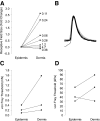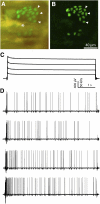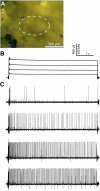The regularity of sustained firing reveals two populations of slowly adapting touch receptors in mouse hairy skin
- PMID: 20393068
- PMCID: PMC2888253
- DOI: 10.1152/jn.00810.2009
The regularity of sustained firing reveals two populations of slowly adapting touch receptors in mouse hairy skin
Abstract
Touch is initiated by diverse somatosensory afferents that innervate the skin. The ability to manipulate and classify receptor subtypes is prerequisite for elucidating sensory mechanisms. Merkel cell-neurite complexes, which distinguish shapes and textures, are experimentally tractable mammalian touch receptors that mediate slowly adapting type I (SAI) responses. The assessment of SAI function in mutant mice has been hindered because previous studies did not distinguish SAI responses from slowly adapting type II (SAII) responses, which are thought to arise from different end organs, such as Ruffini endings. Thus we sought methods to discriminate these afferent types. We developed an epidermis-up ex vivo skin-nerve chamber to record action potentials from afferents while imaging Merkel cells in intact receptive fields. Using model-based cluster analysis, we found that two types of slowly adapting receptors were readily distinguished based on the regularity of touch-evoked firing patterns. We identified these clusters as SAI (coefficient of variation = 0.78 +/- 0.09) and SAII responses (0.21 +/- 0.09). The identity of SAI afferents was confirmed by recording from transgenic mice with green fluorescent protein-expressing Merkel cells. SAI receptive fields always contained fluorescent Merkel cells (n = 10), whereas SAII receptive fields lacked these cells (n = 5). Consistent with reports from other vertebrates, mouse SAI and SAII responses arise from afferents exhibiting similar conduction velocities, receptive field sizes, mechanical thresholds, and firing rates. These results demonstrate that mice, like other vertebrates, have two classes of slowly adapting light-touch receptors, identify a simple method to distinguish these populations, and extend the utility of skin-nerve recordings for genetic dissection of touch receptor mechanisms.
Figures







Similar articles
-
Epidermal Merkel cells are mechanosensory cells that tune mammalian touch receptors.Nature. 2014 May 29;509(7502):617-21. doi: 10.1038/nature13250. Epub 2014 Apr 6. Nature. 2014. PMID: 24717432 Free PMC article.
-
TRPC1 contributes to light-touch sensation and mechanical responses in low-threshold cutaneous sensory neurons.J Neurophysiol. 2012 Feb;107(3):913-22. doi: 10.1152/jn.00658.2011. Epub 2011 Nov 9. J Neurophysiol. 2012. PMID: 22072513 Free PMC article.
-
Mechanotransduction in epidermal Merkel cells.Pflugers Arch. 2015 Jan;467(1):101-8. doi: 10.1007/s00424-014-1569-0. Epub 2014 Jul 23. Pflugers Arch. 2015. PMID: 25053537 Free PMC article. Review.
-
Dual innervation of neonatal Merkel cells in mouse touch domes.PLoS One. 2014 Mar 17;9(3):e92027. doi: 10.1371/journal.pone.0092027. eCollection 2014. PLoS One. 2014. PMID: 24637732 Free PMC article.
-
Mechanosensory perception: are there contributions from bone-associated receptors?Clin Exp Pharmacol Physiol. 2005 Jan-Feb;32(1-2):100-8. doi: 10.1111/j.1440-1681.2005.04136.x. Clin Exp Pharmacol Physiol. 2005. PMID: 15730443 Review.
Cited by
-
Intermittent Failure of Spike Propagation in Primary Afferent Neurons during Tactile Stimulation.J Neurosci. 2019 Dec 11;39(50):9927-9939. doi: 10.1523/JNEUROSCI.0975-19.2019. Epub 2019 Oct 31. J Neurosci. 2019. PMID: 31672792 Free PMC article.
-
The cellular basis of mechanosensory Merkel-cell innervation during development.Elife. 2019 Feb 22;8:e42633. doi: 10.7554/eLife.42633. Elife. 2019. PMID: 30794158 Free PMC article.
-
Diversification and specialization of touch receptors in skin.Cold Spring Harb Perspect Med. 2014 Jun 2;4(6):a013656. doi: 10.1101/cshperspect.a013656. Cold Spring Harb Perspect Med. 2014. PMID: 24890830 Free PMC article. Review.
-
Functional ultrasound (fUS) imaging of displacement-guided focused ultrasound (FUS) neuromodulation in mice.bioRxiv [Preprint]. 2024 Apr 1:2024.03.29.587355. doi: 10.1101/2024.03.29.587355. bioRxiv. 2024. Update in: Neuroimage. 2024 Sep;298:120768. doi: 10.1016/j.neuroimage.2024.120768. PMID: 38617295 Free PMC article. Updated. Preprint.
-
Skin relaxation predicts neural firing rate adaptation in SAI touch receptors.Annu Int Conf IEEE Eng Med Biol Soc. 2010;2010:6678-81. doi: 10.1109/IEMBS.2010.5626264. Annu Int Conf IEEE Eng Med Biol Soc. 2010. PMID: 21096074 Free PMC article.
References
-
- Abramoff MD, Magelhaes PJ, Ram SJ. Image processing with ImageJ. Biophot Int 11: 36–42, 2004
-
- Baumann KI, Chan E, Halata Z, Senok SS, Yung WH. An isolated rat vibrissal preparation with stable responses of slowly adapting mechanoreceptors. Neurosci Lett 213: 1–4, 1996 - PubMed
-
- Boada MD, Woodbury CJ. Physiological properties of mouse skin sensory neurons recorded intracellularly in vivo: temperature effects on somal membrane properties. J Neurophysiol 98: 668–680, 2007 - PubMed
-
- Bourane S, Garces A, Venteo S, Pattyn A, Hubert T, Fichard A, Puech S, Boukhaddaoui H, Baudet C, Takahashi S, Valmier J, Carroll P. Low-threshold mechanoreceptor subtypes selectively express MafA and are specified by Ret signaling. Neuron 64: 857–870, 2009 - PubMed
Publication types
MeSH terms
Substances
Grants and funding
LinkOut - more resources
Full Text Sources

